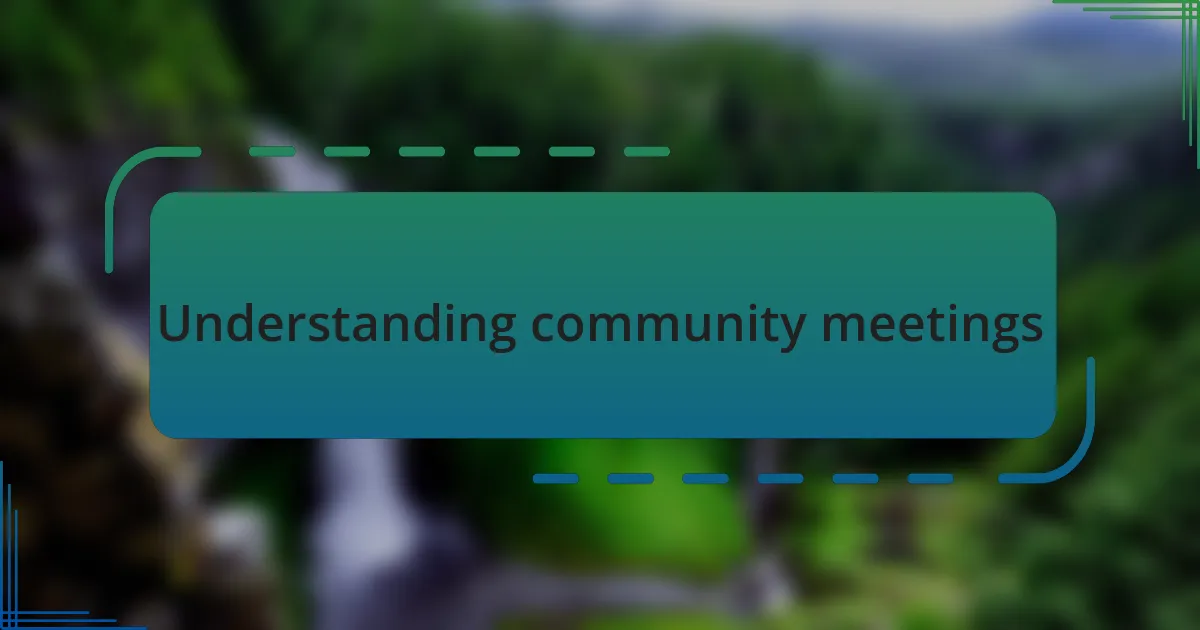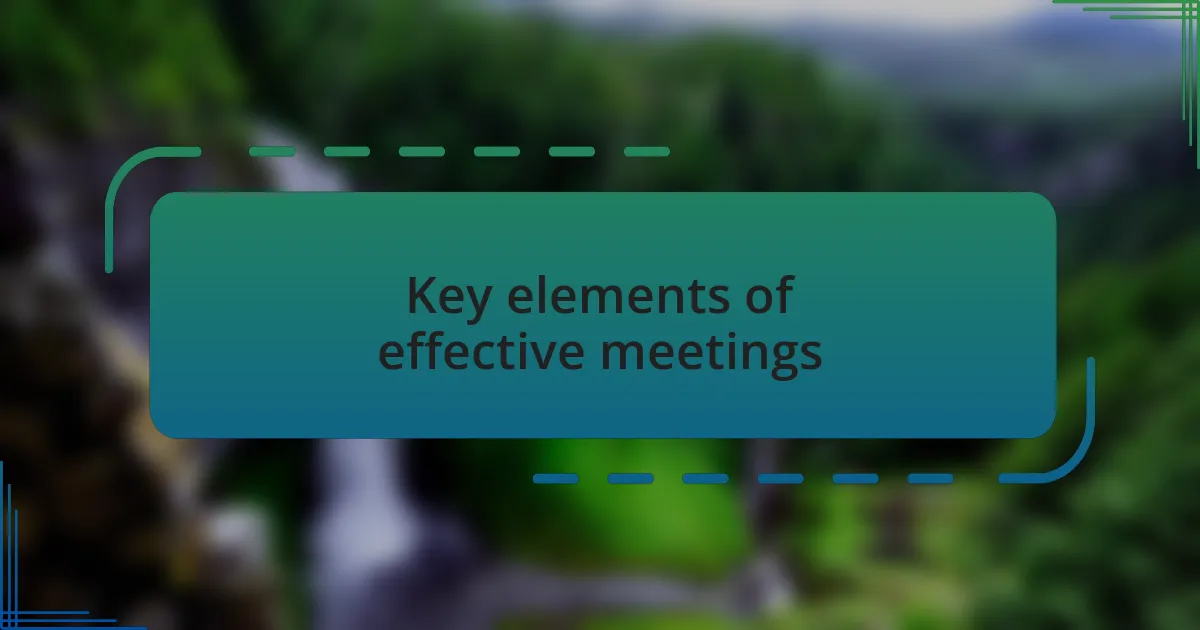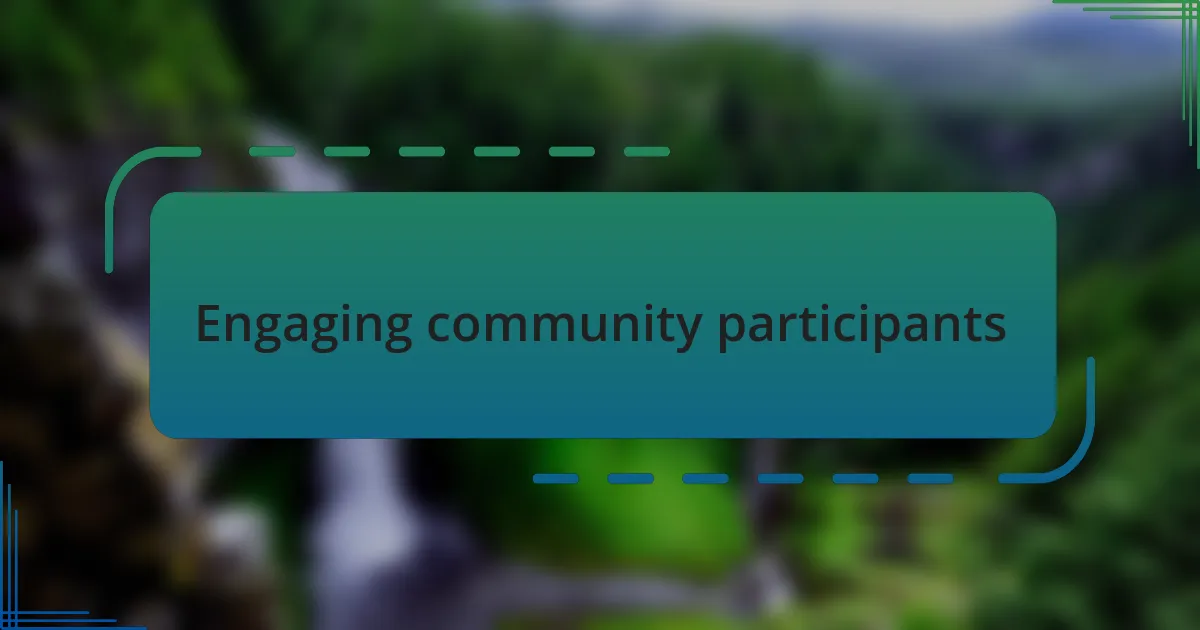Key takeaways:
- Community meetings thrive on clear communication, inclusivity, and structured follow-up to empower participants and maintain momentum.
- Climate action is interlinked with social justice; fostering community engagement can lead to innovative solutions and a stronger sense of belonging.
- Incorporating personal stories, visual aids, and interactive elements significantly enhances participant engagement and fosters meaningful discussions.
- Effective follow-ups after meetings, including summaries and clear action items, are crucial for driving accountability and sustaining enthusiasm.

Understanding community meetings
Community meetings are a vital space for dialogue and connection within neighborhoods. I remember attending my first local gathering, feeling a mix of excitement and apprehension. I wondered: would my voice even matter? This feeling is common, and it’s important to remember that everyone brings valuable perspectives to the table.
Understanding the dynamics of these meetings involves recognizing both their potential and their challenges. I’ve often seen passionate discussions spark innovative ideas, but I’ve also witnessed how quickly a lack of structure can derail important conversations. Isn’t it fascinating how a simple agenda can transform a chaotic discussion into a productive brainstorming session?
We often forget that community meetings are about collective empowerment, not just information sharing. I once watched neighbors bond over shared concerns, overcoming their initial hesitations to collaborate on initiatives that affected us all. It was a powerful reminder that every voice contributes to the melody of community action, creating harmony through shared goals and collaborative effort.

Importance of climate action
Climate action is essential because it directly impacts the health and well-being of our communities. I recall a time when my neighborhood experienced unusually severe flooding, leaving families displaced and businesses struggling. This catastrophe highlighted the immediate effects of climate change and reinforced the urgency of proactive measures to protect our loved ones and environment.
Taking action against climate change isn’t just about the environment; it’s about social justice and equity as well. I remember speaking with a local activist who shared stories of marginalized communities facing the brunt of pollution and extreme weather. It struck me how interconnected our fates are—a healthy planet is a shared responsibility, and when we advocate for climate action, we stand up for everyone’s right to a safe and thriving community.
Moreover, engaging in climate action fosters a sense of purpose and belonging. When I participated in a tree-planting initiative, I felt an overwhelming sense of unity and pride in contributing to something greater. It made me ask myself: how many lives can we change when we work together toward a healthier planet? This collective effort builds resilience, empowering us to confront future challenges with hope and determination.

Key elements of effective meetings
Effective meetings are rooted in clear communication. During a recent community gathering, I noticed how crucial it was to have a well-defined agenda shared in advance. When everyone was on the same page, discussions flowed more smoothly, allowing us to tackle important climate action topics without getting sidetracked. Have you ever sat through a meeting where everyone seemed confused? It’s frustrating and a waste of time.
Another key element is inclusivity. I remember attending a local climate forum where diverse voices were not only welcomed but encouraged. It was inspiring to hear perspectives from young activists, older residents, and even local business owners. Each participant brought their unique experiences and ideas to the table, enriching our discussion and leading to more innovative solutions. How often do we overlook the wisdom within our communities simply because we don’t create space for it?
Lastly, follow-up is essential for effective meetings. After organizing a workshop on renewable energy, I took the initiative to send out a summary of our discussions and next steps. This not only kept momentum alive but also showed attendees that their input mattered. Isn’t it empowering when actions result from conversations? Keeping that connection alive motivates participants to remain engaged and committed to our common goals.

Tips for organizing climate meetings
When organizing climate meetings, consider the venue carefully. I once coordinated a session in a community garden, which created a relaxed atmosphere and reminded everyone why we were there. Choosing a space that resonates with the topic not only enhances engagement but also fosters a sense of connection to the climate issues at hand. Isn’t it amazing how the right setting can inspire people to open up and share their concerns?
Another tip is to engage participants before the meeting. A few weeks prior to a local climate workshop, I reached out to attendees, asking them to share their thoughts and questions. This not only helped shape the agenda, but it also made everyone feel valued and invested in the outcome. Have you ever felt more excited about an event because your voice was heard beforehand? It truly sets the stage for a lively and productive discussion.
Lastly, think about incorporating interactive elements. During a recent meeting, we utilized small group discussions where participants brainstormed solutions to climate challenges together. This hands-on approach encouraged collaboration and led to a wealth of creative ideas. How often do we stick to traditional formats and miss out on these vibrant opportunities? Emphasizing participation can transform the energy of any gathering, making everyone feel like a crucial part of the movement for change.

Engaging community participants
Engaging community participants goes beyond simple attendance; it’s about fostering a sense of belonging. I’ve seen firsthand how starting the meeting with a personal story about my own journey into climate activism sparked lively conversations. When people connect on an emotional level, it can shift the atmosphere from one of obligation to true enthusiasm. Isn’t it remarkable how sharing a piece of yourself can create a ripple effect of openness?
Another effective technique is to incorporate visual aids that resonate with your audience. I remember once using infographics about local climate impacts at a meeting. Watching people’s eyes light up as they connected the data to their own experiences made it clear that visuals can be powerful storytelling tools. How do you feel when statistics come alive through images that reflect your reality? It transforms abstract concepts into relatable issues that spur discussion.
Lastly, I often encourage attendees to share their own environmental projects or experiences. There was a time when a participant shared her effort in starting a zero-waste initiative, which inspired others to contribute their ideas. It’s amazing how individual stories can weave together into a collective narrative, igniting passion and innovation. Have you ever left a meeting feeling motivated simply because someone else’s enthusiasm was contagious? Creating that space for sharing is invaluable in sustaining engagement and community spirit.

Facilitating productive discussions
When I facilitate discussions, I find it essential to establish ground rules that promote respect and encourage everyone’s participation. One time, I asked participants to share one positive outcome of climate action before we delved into challenges. This simple shift in focus created a supportive environment. Have you ever noticed how a positive foundation can change the tone of a conversation? It really can inspire more open and honest sharing.
I also believe in the power of asking open-ended questions. During a recent meeting, I prompted the group with, “What innovative solutions have you seen in our community?” This led to a dynamic exchange of ideas, with everyone contributing thoughts that enriched our dialogue. I’ve learned that when questions inspire creativity, they unlock a treasure trove of insights. What’s your experience with asking the right questions in a group setting?
Finally, incorporating small group discussions or breakout sessions can significantly enhance engagement. I recall a workshop where I broke participants into pairs to discuss their hopes for our community’s climate future. The immediate shift from the larger group to intimate conversations sparked a depth of connection that revealed untapped ideas. Have you experienced that moment when smaller conversations reveal more than a larger group discussion ever could? It’s a fantastic way to empower voices that might otherwise remain silent in a big crowd.

Following up after meetings
After the meeting wraps up, the real work begins with effective follow-ups. I make it a priority to send a summary email that highlights key discussions and decisions made. Last month, I shared a recap with participants from a climate initiative, and one person immediately responded with a new idea, taking our dialogue to the next level. I’ve found that a simple follow-up can reignite enthusiasm and keep the momentum going.
In addition to summaries, I find setting clear action items is vital. I remember a meeting where we brainstormed several project ideas, but without designated tasks, progress stalled. Assigning specific responsibilities not only drives accountability but also fosters a sense of ownership among participants. Have you ever noticed how clarity on next steps can energize a group?
Lastly, I believe in the power of personal connections when following up. A quick message or phone call to check in with a participant can strengthen relationships and build trust. During a recent project, I reached out to a quieter member, and we had a delightful conversation that led to them stepping more into the spotlight in future meetings. It emphasizes how sometimes, a personal touch can create ripples of engagement that transform entire discussions.